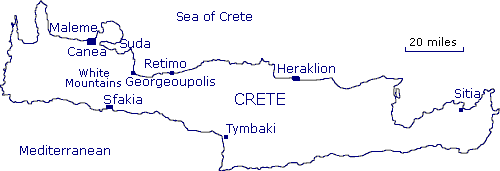

Freyberg, Puttick and CreteCol RH Dyson MBE EDIn the course of an interview by Megan Hutching for her book on the battle for Crete in WW2, "A Unique Sort of Battle", Colonel Dyson related his experience at HQ NZ Div as it happened. This article is his account based on subsequent service experience, of General Freyberg's refusal to accept Brigadier Puttick's recommendations to silence the anti-aircraft guns before the Battle and to conceal them. | |
|
In April 1941, large numbers of battle-weary under-equipped Allied troops, commanded by General Freyberg, were sent to Crete in anticipation of a German invasion of the island. Because the seas were controlled by the Royal Navy, Hitler launched a purely airborne invasion (Operation Mercury) on 20 May 1941 using 13000 paratroops, 9000 mountain troops, 500 warplanes, 500 transports and 80 gliders against the defenders' two dozen fighter planes, twenty-odd tanks and scant anti-aircraft defences. Let down by poor communications, the New Zealanders could not hold Maleme airstrip in the north, and the Germans gained a valuable foothold. On 26 May 1941, Freyberg decided the position was hopeless and ordered a retreat to the southern port of Sfakia. Heavy losses were suffered on both sides, and the Germans abandoned similar attacks and returned to North Africa. |

To WW2 page |
|
In CRETE the writer (then a Lieutenant) was instructed to report to HQ NZ Div as an "A/Q swinger". My tasks were given by the A/Q, Lieutenant Colonel JN Peart who was heavily committed to dealing with a multitude of critical shortages of equipment - not trivia. I was night duty officer on 19 May 1941 when General Freyberg wanted to speak to the Divisional Commander, Brigadier Puttick (later LtGen Sir Edward Puttick), about 10 pm. An hour long discussion was mainly about the deployment and employment of the anti-aircraft artillery. Brigadier Puttick did not have a CRA (Commander Royal Artillery) at Div HQ. The only CRA was at HQ CREFORCE. Notwithstanding this, Brigadier Puttick had correctly concluded that the AA guns should be concealed and should remain silent until the attack was launched (next day, 20 May 1941, as it happened). Asked by General Freyberg when he would order the guns to move, Brigadier Puttick said immediately they would be concealed. The Official History records that Brigadier Puttick had previously criticised the lack of concealment at Maleme air strip, as did the Brigade Commander, Brigadier Hargest. However, General Freyberg did not agree. He may have had seaborne invasion in mind.
Air raids were a daily occurence in Crete which gradually became more intensive. As a result of continuing engagement by the defenders' AA, gun positions became well known to the Luftwaffe. The result was disastrous. On 20 May the German forces opened with the saturation bombing of the AA and other defences. Then followed an attack by the paratroops and airborne troops in gliders. Transport aircraft and those towing gliders flying low and slow between 300 and 600 feet would have been destroyed whenever they came within range of the guns, particularly the quick firing Bofors. Fighter interdiction would have been impossible. The casualties inflicted by our infantry were heavy - this on the basis of one Kiwi soldier killing one paratrooper at a time. Had Brigadier Puttick's suggested policy been adopted, one AA gun would shoot down a plane-load at a time, be it paratroopers or airborne troops in gliders. A Gun Operations Room was being established in Canea but the process was hampered by a shortage of communications and controllers. This sort of thing is essential for static guns and for the defence of ports, air bases and large cities but NOT in the fluid conditions likely to prevail on the battlefield. The anti-aircraft guns included 3 inch, 3.7 inch and 40 mm Bofors with a high rate of fire. Some guns, like the guns of the coast artillery, were static. The field artillery comprised French and Italian 75 mm guns, some without sights, and 3.7 inch howitzers. The shortage of signals equipment precluded centralised fire control as introduced later in North Africa with the introduction of the No. 19 Wireless Set. Both Crete and Greece campaigns were strategic blunders by the politicians. The defeat of the Italian Army by the Desert Army under General O'Connor was not exploited. Rommel established the Afrika Corps in Tunisia without hindrance and moved to Libya and eventually to Egypt culminating in the Battle of Alamein. RH Dyson, 2001 NZ artillery in Europe and Africa in WW2 | Tales from the Trails index | Home | |
